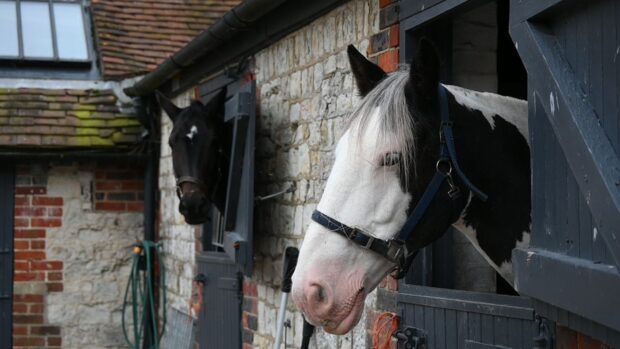Heatstroke in horses occurs when the animal’s body temperature increases to a point above which its natural cooling system fails to work effectively, so it starts to cook rather than cool the horse.
Any horse undergoing fast, strenuous work is at risk of heatstroke, particularly in hot and humid conditions. It is important to consider fluid and electrolyte intake in addition to fitness, as even relatively small degrees of dehydration can affect a horse’s performance. Heatstroke can also occur when a horse is left in a trailer that is standing in full sun.
The causes of heatstroke in horses include:
- hot and humid conditions, because high humidity prevents efficient evaporation of sweat and body cooling
- a lack of opportunity to acclimatised to the heat
- a horse that is unfit, overweight or has a thick coat
- a lack of fluid and body salts, which can lead to “exhausted horse complex”. In such a case, the horse overheats and becomes severely dehydrated, impairing its circulation and causing muscle fatigue, which can result in shock and collapse
Signs to watch out for include a raised temperature of 41-42°C or above. An affected horse will appear obviously distressed and will be unable to continue exercise.
If you suspect a horse is suffering from heatstroke, then he needs to be cooled as quickly as possible. Apply cold (4-10°C) water to as much of its body as is practical, including the hindquarters, either while gently walking the horse or allow the horse to stand the horse in a shady area, ideally where there is a breeze, while soaking. Do not spend time scraping the water off the horse as this will not increase the cooling effect – just keep applying more cold water over the whole of the horse’s body.
The horse should frequently be offered around half a bucket of electrolyte solution to drink, but if he will not take that, try plain water. Paradoxically, some dehydrated horses will not drink, as the thirst response is triggered by an increase in sodium, which is lost in sweat. If your horse refuses liquid, your vet may have to administer fluids using a stomach tube. This is passed up the horse’s nose, before being directed down towards its stomach.
However, it can be difficult to pass a tube into the stomach of an exhausted horse and this may produce a nosebleed. Additionally, in a very sick animal the fluid may simply pool in the gut and not be absorbed. As a result, an obviously sick or severely dehydrated horse requires fluids to be given directly into the blood circulation by a sterile catheter, which is usually placed in the main jugular vein in the neck. Large volumes of fluid and electrolytes can be given in this way.
Top tips to prevent heatstroke in horses
- Stick to the shade and avoid strenuous exercise between noon and 3pm
- Remember that weather forecasts quote the temperature in the shade, so a horse out in a field with no shade or shelter and limited water supply can suffer bad heatstroke
- Avoid leaving horses standing in horseboxes or trailers in direct sun
- Do not leave your horse shut in a hot stuffy stable when there is no breeze
- Allow small drinks at intervals during exercise – including directly before competing
- Give soaked hay and sloppy, wet feeds to help get water on board
- Rapid rehydration will not be possible with water alone as electrolytes, particularly sodium, are needed. There are a variety of commercially available equine oral replacement electrolyte solutions on the market, but it is important they are made up at the correct concentration and that your horse will take them. Adding apple squash or apple juice helps to mask the taste
Signs of dehydration
Traditionally, dehydration in horses is determined by the skin ‘pinch test’. A couple of centimetres of skin over the shoulder is pinched gently between finger and thumb, then released. In a hydrated horse, it will ‘ping’ rapidly back into place. In a seriously dehydrated horse, a small residual fold of skin will remain. However, this test is not 100 per cent reliable as the elasticity of skin varies from horse to horse.
Performance may be affected below the level that a skin pinch test would detect, so other signs must be assessed. These include:
- Dry or tacky gums
- A weak, fast pulse
- Sunken eyes
- Cool extremities
You may also be interested in…

8 essential tips to help keep your horse cool when temperatures soar

How to avoid your horse suffering from sunburn this summer

How to survive a heatwave — whether you have a hairy cob or a competition horse

Subscribe to Horse & Hound magazine today – and enjoy unlimited website access all year round
Horse & Hound magazine, out every Thursday, is packed with all the latest news and reports, as well as interviews, specials, nostalgia, vet and training advice. Find how you can enjoy the magazine delivered to your door every week, plus options to upgrade your subscription to access our online service that brings you breaking news and reports as well as other benefits.



